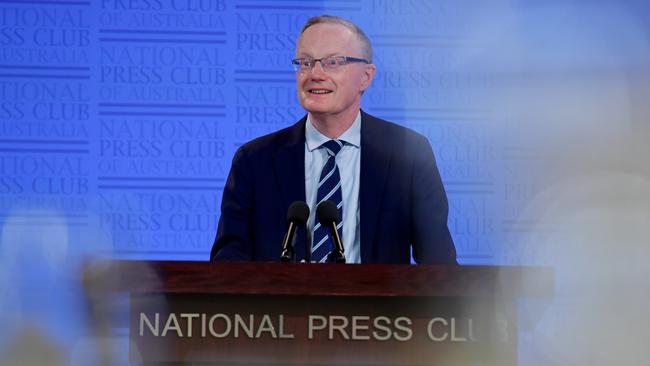RBA governor Philip Lowe explains cautious outlook on rates, wages
The Reserve Bank would rather do too much than too little, and it’s not just about the pandemic.

The Reserve Bank would rather do too much than too little, and it’s not just about the pandemic.
Asked about his confidence in the central bank’s expectation that its preconditions — including actual inflation “sustainably within the 2-3 per cent target band” — for saying a rise in official interest rates won’t be met until “2024 at the earliest”, RBA governor Philip Lowe replied: “It is certainly possible, and I hope the unemployment rate comes down more quickly than we have forecast.”
“But even if it does, we discussed at the board and internally at the bank the experience before the pandemic where we had unemployment rates at 40- and 50-year lows in the US, the UK and actually even in NSW, where the unemployment rate was as low as it was in 1973,” he added.
“And even then wage growth was kind of two, two and a bit (per cent per annum), so there are some really powerful structural factors at work not just in Australia, but globally — like the globalisation of the supply chain, how it relates to technology, (and) changes in the power between workers and firms.
“So there are really powerful structural factors that mean that you have to have a very tight labour market and low unemployment rates to get wages increasing materially.”
COVID-19 was a major shock, but the RBA missed its inflation targets for years and the economy needed fresh stimulus before the pandemic struck, following the bushfire crisis and the drought.
The pandemic gave the government and the RBA the pretext to not only “build a bridge” through COVID-19, but actually get the economy back on a sustainable growth keel.
Even with the crippling Victorian lockdown in the second half of 2020, the RBA’s updated forecasts on Friday will show the economy did better than expected in the past six months and the outlook has improved due to stimulus as well as the confidence afforded by COVID-19 vaccine developments.
It was a big step for the RBA to cut interest rates to almost zero and start quantitative easing in November, so baring a “melt-up” in the property market or a sustained outbreak of consumer price inflation, it might as well stay near “maximum dovish” until its goals are met.
Dr Lowe did say there are no signs of the kind of “marked deterioration” in financial system funding and credit conditions that would lead the RBA to consider extending its Term Funding Facility when the program ends in June — noting this will give banks the benefit of low-cost funding out to mid-2024. But he said it was “premature to be considering withdrawal of the monetary stimulus”, implying that it doesn’t see the end of the TFF as having a material impact.
The RBA will also consider whether to roll forward its current 3-year bond rate target from the April 2024 to the November 2024 bond “later in the year” after “giving close attention to the flow of economic data and the outlooks for inflation and jobs”.
But Dr Lowe said while “we do not expect (a rate increase) to be before 2024 … it is possible that it will be later than this.” If so, the RBA will almost certainly roll forward its bond target.
And after being surprised by the timing and, in some cases, the size of Tuesday’s announcement of another $100bn QE program — before the current one expires in mid-April and at the same aggressive pace of $5bn a month — some predict a third $100bn QE.
“We are more upbeat about the outlook for the economy than the Reserve Bank,” said Capital Economics economist Marcel Thieliant. “But the RBA seems keen to err on the side of caution.
“With the latest extension of its QE program already ending in August, we suspect the bank will announce one last $100bn round of purchases at its June meeting.”
Still, with capital city house prices back above pre-COVID levels and house prices in Sydney up 2 per cent in the past month, Dr Lowe faces a grilling on the financial stability risks when he appears before the House of Representatives on Friday morning.
Additional reporting: Lachlan Moffett Gray






To join the conversation, please log in. Don't have an account? Register
Join the conversation, you are commenting as Logout